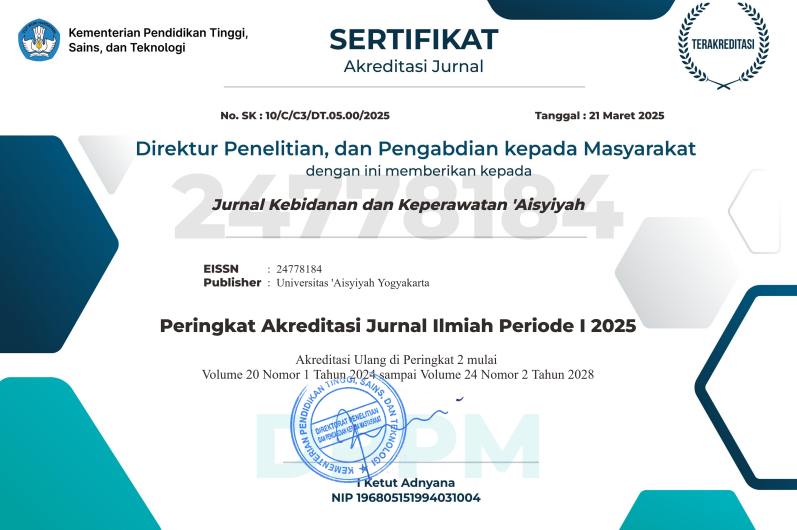The Relationship between the Length of Seeking Help and the Severity of Stroke Patients
DOI:
https://doi.org/10.31101/jkk.3112Abstract views 1048 times
Keywords:
length of seeking help; response time; severity of strokeAbstract
Downloads
References
Aigner, A., Grittner, U., Rolfs, A., Norrving, B., Siegerink, B., & Busch, M. A. (2017). Contribution of Established Stroke Risk Factors to the Burden of Stroke in Young Adults. Stroke, 48(7), 1744–1751. https://doi.org/10.1161/STROKEAHA.117.016599
Al Khathaami, A. M., Mohammad, Y. O., Alibrahim, F. S., & Jradi, H. A. (2018). Factors associated with late arrival of acute stroke patients to emergency department in Saudi Arabia. SAGE Open Medicine, 6, 2050312118776719. https://doi.org/10.1177/2050312118776719
Arba, F., Quinn, T., Hankey, G. J., Inzitari, D., Ali, M., Lees, K. R., & VISTA Collaboration. (2017). Determinants of post-stroke cognitive impairment: Analysis from VISTA. Acta Neurologica Scandinavica, 135(6), 603–607. https://doi.org/10.1111/ane.12637
Aslam, A., Khan, U., Niazi, F., & Anwar, I. (2022). Etiology and risk factors of stroke in young adults: A multicentric study. Annals of Medicine and Surgery, 82, 104647. https://doi.org/10.1016/j.amsu.2022.104647
Banerjee, C., & Chimowitz, M. I. (2017). Stroke Caused by Atherosclerosis of the Major Intracranial Arteries. Circulation Research, 120(3), 502–513. https://doi.org/10.1161/CIRCRESAHA.116.308441
BPJS Kesehatan. (2023). Laporan Pengelolaan Program dan Keuangan BPJS Kesehatan Tahun 2022. BPJS KEeehatan RI. https://web.bpjs-kesehatan.go.id/uploads/information/07082023034741-24f2a7ac-758a-48c5-99c1-d4e261418101.pdf
Corbière, S., & Tettenborn, B. (2021). Stroke in women: Is it different? Clinical and Translational Neuroscience, 5(1), 2514183X211014514. https://doi.org/10.1177/2514183X211014514
Demel, S. L., Kittner, S., Ley, S. H., McDermott, M., & Rexrode, K. M. (2018). Stroke Risk Factors Unique to Women. Stroke, 49(3), 518–523. https://doi.org/10.1161/STROKEAHA.117.018415
Dinas Kesehatan Provinsi Jawa Tengah. (2022). Profil Kesehatan Jawa Tengah Tahun 2021. https://dinkesjatengprov.go.id/v2018/dokumen/Profil_Kesehatan_2021/files/downloads/Profil%20Kesehatan%20Jateng%202021.pdf
Dinas Kesehatan Provinsi Jawa Tengah. (2023). Profil Kesehatan Provinsi Jawa Tengah Tahun 2022. Dinas Kesehatan Provinsi Jawa Tengah. https://jateng.bps.go.id/publication/2023/05/30/be07aa22ae941fcedfa8aeca/profil-kesehatan-provinsi-jawa-tengah-2022.html
El Nahas, N., Aref, H., Kenawy, F. F., Georgy, S., Abushady, E. M., Dawood, N. L., Hamdy, S., Abdelmohsen, N., Hassan Abdel Hamid, Y., Roushdy, T., & Shokri, H. (2023). Stroke in women: Experience in a developing country. BMC Neurology, 23(1), 271. https://doi.org/10.1186/s12883-023-03314-3
Ellis, C. (2013). In-hospital delays for stroke care: Losing sight of patient-centered care. European Journal for Person Centered Healthcare, 1(2), Article 2. https://doi.org/10.5750/ejpch.v1i2.673
Fassbender, K., Balucani, C., Walter, S., Levine, S. R., Haass, A., & Grotta, J. (2013). Streamlining of prehospital stroke management: The golden hour. The Lancet. Neurology, 12(6), 585–596. https://doi.org/10.1016/S1474-4422(13)70100-5
Feigin, V. L., Brainin, M., Norrving, B., Martins, S., Sacco, R. L., Hacke, W., Fisher, M., Pandian, J., & Lindsay, P. (2022). World Stroke Organization (WSO): Global Stroke Fact Sheet 2022. International Journal of Stroke, 17(1), 18–29. https://doi.org/10.1177/17474930211065917
Feigin, V. L., Stark, B. A., Johnson, C. O., Roth, G. A., Bisignano, C., Abady, G. G., Abbasifard, M., Abbasi-Kangevari, M., Abd-Allah, F., Abedi, V., Abualhasan, A., Abu-Rmeileh, N. M., Abushouk, A. I., Adebayo, O. M., Agarwal, G., Agasthi, P., Ahinkorah, B. O., Ahmad, S., Ahmadi, S., … Murray, C. J. L. (2021). Global, regional, and national burden of stroke and its risk factors, 1990–2019: A systematic analysis for the Global Burden of Disease Study 2019. The Lancet Neurology, 20(10), 795–820. https://doi.org/10.1016/S1474-4422(21)00252-0
Girijala, R. L., Sohrabji, F., & Bush, R. L. (2017). Sex differences in stroke: Review of current knowledge and evidence. Vascular Medicine, 22(2), 135–145. https://doi.org/10.1177/1358863X16668263
Hackett, M. L., & Pickles, K. (2014). Part I: Frequency of depression after stroke: an updated systematic review and meta-analysis of observational studies. International Journal of Stroke: Official Journal of the International Stroke Society, 9(8), 1017–1025. https://doi.org/10.1111/ijs.12357
Ishariani, L., & Rachmania, D. (2021). Hubungan Respon Time Keluarga dalam Membawa Pasien Stroke ke Pelayanan Kesehatan dengan Tingkat Keparahan Pasien Stroke. The Indonesian Journal of Health Science, 13(1), Article 1. https://doi.org/10.32528/ijhs.v13i1.5274
Jackson, C. A., Sudlow, C. L. M., & Mishra, G. D. (2018). Education, sex and risk of stroke: A prospective cohort study in New South Wales, Australia. BMJ Open, 8(9), e024070. https://doi.org/10.1136/bmjopen-2018-024070
Jacobs, M. M., & Ellis, C. (2021). Heterogeneity among women with stroke: Health, demographic and healthcare utilization differentials. BMC Women’s Health, 21(1), 160. https://doi.org/10.1186/s12905-021-01305-5
Keller, K., Geyer, M., Münzel, T., & Ostad, M. A. (2018). Gender-differences in prevalence and outcome of ischemic stroke and promoting factors of atrial thrombi. Artery Research, 22(C), 68. https://doi.org/10.1016/j.artres.2018.05.004
Kementerian Kesehatan RI. (2019). Laporan Riskesdas 2018 Nasional. Lembaga Penerbit Badan Penelitian dan Pengembangan Kesehatan Kementerian KesehatanRI. https://kesmas.kemkes.go.id/assets/upload/dir_519d41d8cd98f00/files/Hasil-riskesdas-2018_1274.pdf
Kementerian Kesehatan RI. (2018, July 4). Apa itu Stroke? - Direktorat P2PTM. https://p2ptm.kemkes.go.id/infographic-p2ptm/stroke/apa-itu-stroke
Khaku, A. S., & Tadi, P. (2023). Cerebrovascular Disease. In StatPearls. StatPearls Publishing. http://www.ncbi.nlm.nih.gov/books/NBK430927/
Khan, M., Wasay, M., O’Donnell, M. J., Iqbal, R., Langhorne, P., Rosengren, A., Damasceno, A., Oguz, A., Lanas, F., Pogosova, N., Alhussain, F., Oveisgharan, S., Czlonkowska, A., Ryglewicz, D., & Yusuf, S. (2023). Risk Factors for Stroke in the Young (18–45 Years): A Case-Control Analysis of INTERSTROKE Data from 32 Countries. Neuroepidemiology, 57(5), 275–283. https://doi.org/10.1159/000530675
Kusyani, A. (2019). Hubungan Pengetahuan Keluarga Dengan Lama Waktu Kedatangan Pasien Stroke Iskemik Ke Igd Rsud Jombang. Well Being, 4(1), 21–28.
Lekander, I., Willers, C., Euler, M. von, Lilja, M., Sunnerhagen, K. S., Pessah-Rasmussen, H., & Borgström, F. (2017). Relationship between functional disability and costs one and two years post stroke. PLOS ONE, 12(4), e0174861. https://doi.org/10.1371/journal.pone.0174861
Li, A., Ji, Y., Zhu, S., Hu, Z., Xu, X., Wang, Y., & Jian, X. (2022). Risk probability and influencing factors of stroke in followed-up hypertension patients. BMC Cardiovascular Disorders, 22(1), 328. https://doi.org/10.1186/s12872-022-02780-w
Madsen, T. E., Howard, G., Kleindorfer, D. O., Furie, K. L., Oparil, S., Manson, J. E., Liu, S., & Howard, V. J. (2019). Sex Differences in Hypertension and Stroke Risk in the REGARDS Study. Hypertension, 74(4), 749–755. https://doi.org/10.1161/HYPERTENSIONAHA.119.12729
Madsen, T. E., Howard, V. J., Jiménez, M., Rexrode, K. M., Acelajado, M. C., Kleindorfer, D., & Chaturvedi, S. (2018). Impact of Conventional Stroke Risk Factors on Stroke in Women. Stroke, 49(3), 536–542. https://doi.org/10.1161/STROKEAHA.117.018418
Madsen, T. E., Khoury, J. C., Leppert, M., Alwell, K., Moomaw, C. J., Sucharew, H., Woo, D., Ferioli, S., Martini, S., Adeoye, O., Khatri, P., Flaherty, M., De Los Rios La Rosa, F., Mackey, J., Mistry, E., Demel, S. L., Coleman, E., Jasne, A., Slavin, S. J., … Kleindorfer, D. O. (2020). Temporal Trends in Stroke Incidence Over Time by Sex and Age in the GCNKSS. Stroke, 51(4), 1070–1076. https://doi.org/10.1161/STROKEAHA.120.028910
McCarthy, J., Yang, J., Clissold, B., Young, M. J., Fuller, P. J., & Phan, T. (2021). Hypertension Management in Stroke Prevention. Stroke, 52(10), e626–e634. https://doi.org/10.1161/STROKEAHA.120.033990
Meng, Q., Li, Y., Ji, T., Chao, Y., Li, J., Fu, Y., Wang, S., Chen, Q., Chen, W., Huang, F., Wang, Y., Zhang, Q., Wang, X., & Bian, H. (2021). Estrogen prevent atherosclerosis by attenuating endothelial cell pyroptosis via activation of estrogen receptor α-mediated autophagy. Journal of Advanced Research, 28, 149–164. https://doi.org/10.1016/j.jare.2020.08.010
Mondal, M. B. A., Hasan, A. T. M. H., Khan, N., & Mohammad, Q. D. (2022). Prevalence and risk factors of stroke in Bangladesh: A nationwide population-based survey. ENeurologicalSci, 28, 100414. https://doi.org/10.1016/j.ensci.2022.100414
Muchada, M., Rubiera, M., Rodriguez-Luna, D., Pagola, J., Flores, A., Kallas, J., Sanjuan, E., Meler, P., Alvarez-Sabin, J., Ribo, M., & Molina, C. A. (2014). Baseline National Institutes of Health Stroke Scale–Adjusted Time Window for Intravenous Tissue-Type Plasminogen Activator in Acute Ischemic Stroke. Stroke, 45(4), 1059–1063. https://doi.org/10.1161/STROKEAHA.113.004307
Olvera Lopez, E., Ballard, B. D., & Jan, A. (2023). Cardiovascular Disease. In StatPearls. StatPearls Publishing. http://www.ncbi.nlm.nih.gov/books/NBK535419/
Rachmawati, D., Andarini, S., & Ningsih, D. K. (2017). Pengetahuan Keluarga Berperan terhadap Keterlambatan Kedatangan Pasien Stroke Iskemik Akut di Instalasi Gawat Darurat. Jurnal Kedokteran Brawijaya, 369–376. https://doi.org/10.21776/ub.jkb.2017.029.04.15
Rahayu, E. O. (2016). Perbedaan Risiko Stroke Berdasarkan Faktor Risiko Biologi pada Usia Produktif. Jurnal Berkala Epidemiologi, 4(September 2016), 113–125. https://doi.org/10.20473/jbe.v4i1.113-125
Ramos-Lima, M. J. M., Brasileiro, I. de C., de Lima, T. L., & Braga-Neto, P. (2018). Quality of life after stroke: Impact of clinical and sociodemographic factors. Clinics, 73, e418. https://doi.org/10.6061/clinics/2017/e418
Rexrode, K. M., Madsen, T. E., Yu, A. Y. X., Carcel, C., Lichtman, J. H., & Miller, E. C. (2022). The Impact of Sex and Gender on Stroke. Circulation Research, 130(4), 512–528. https://doi.org/10.1161/CIRCRESAHA.121.319915
Rizaldy Pinzon, L. A. (2019). Awas stroke!: Pengertian, gejala tindakan, perawatan dan pencegahan (1st ed.). Penerbit Andi. http://repo.upertis.ac.id/984/
Sarfo, F. S., Agbenorku, M., Adamu, S., Obese, V., Berchie, P., & Ovbiagele, B. (2019). The Dynamics of Poststroke Depression among Ghanaians. Journal of the Neurological Sciences, 405, 116410. https://doi.org/10.1016/j.jns.2019.07.028
Saudin, D., & Rajin, M. (2017). METODE PENGKAJIAN NEUROLOGIS MENGGUNAKAN NATIONAL INSTITUTES OF HEALTH STROKE SCALE (NIHSS) PADA PASIEN STROKE DI INSTALASI GAWAT DARURAT DI RSUD DR ISKAK TULUNGAGUNG. 1(1).
Vyas, M. V., Hackam, D. G., Silver, F. L., Laporte, A., & Kapral, M. K. (2016). Lost Productivity in Stroke Survivors: An Econometrics Analysis. Neuroepidemiology, 47(3–4), 164–170. https://doi.org/10.1159/000454730
Wandira, R. D., Amalia, L., & Fuadi, I. (2018). HUBUNGAN ANTARA DERAJAT KEPARAHAN STROKE DENGAN KEJADIAN STROKE-ASSOCIATED PNEUMONIA. Majalah Kedokteran Neurosains Perhimpunan Dokter Spesialis Saraf Indonesia, 35(2), Article 2. https://doi.org/10.52386/neurona.v35i2.20
Xie, F., Li, X., Xu, Y., Cheng, D., Xia, X., Lv, X., Yuan, G., & Peng, C. (2022). Estrogen Mediates an Atherosclerotic-Protective Action via Estrogen Receptor Alpha/SREBP-1 Signaling. Frontiers in Cardiovascular Medicine, 9, 895916. https://doi.org/10.3389/fcvm.2022.895916
Xiuyun, W., Qian, W., Minjun, X., Weidong, L., & Lizhen, L. (2020). Education and stroke: Evidence from epidemiology and Mendelian randomization study. Scientific Reports, 10(1), Article 1. https://doi.org/10.1038/s41598-020-78248-8
Yi, X., Luo, H., Zhou, J., Yu, M., Chen, X., Tan, L., Wei, W., & Li, J. (2020). Prevalence of stroke and stroke related risk factors: A population based cross sectional survey in southwestern China. BMC Neurology, 20(1), 5. https://doi.org/10.1186/s12883-019-1592-z
Yousufuddin, M., & Young, N. (2019). Aging and ischemic stroke. Aging (Albany NY), 11(9), 2542–2544. https://doi.org/10.18632/aging.101931
Zhang, F.-L., Guo, Z.-N., Wu, Y.-H., Liu, H.-Y., Luo, Y., Sun, M.-S., Xing, Y.-Q., & Yang, Y. (2017). Prevalence of stroke and associated risk factors: A population based cross sectional study from northeast China. BMJ Open, 7(9), e015758. https://doi.org/10.1136/bmjopen-2016-015758
Downloads
Published
How to Cite
Issue
Section
License
Copyright (c) 2023 Jurnal Kebidanan dan Keperawatan Aisyiyah

This work is licensed under a Creative Commons Attribution-ShareAlike 4.0 International License.
With the receipt of the article by the Jurnal Kebidanan dan Keperawatan Aisyiyah Editorial Board and the decision to be published, then the copyright regarding the article will be diverted to Jurnal Kebidanan dan Keperawatan Aisyiyah. Universitas 'Aisyiyah Yogyakarta as the publisher of Jurnal Kebidanan dan Keperawatan Aisyiyah hold the copyright regarding all the published articles in this journal.
Jurnal Kebidanan dan Keperawatan Aisyiyah is licensed under a Creative Commons Attribution-ShareAlike 4.0 International License.
















